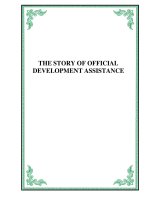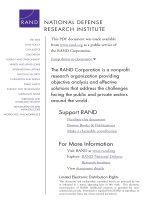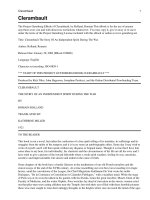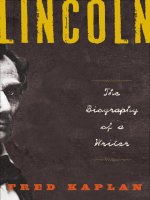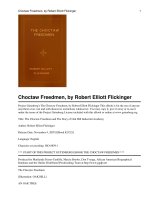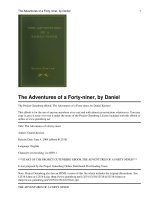Beethoven The story of a little boy who was forced to practice ppt
Bạn đang xem bản rút gọn của tài liệu. Xem và tải ngay bản đầy đủ của tài liệu tại đây (757.3 KB, 14 trang )
Beethoven, by Thomas Tapper
The Project Gutenberg EBook of Beethoven, by Thomas Tapper This eBook is for the use of anyone
anywhere at no cost and with almost no restrictions whatsoever. You may copy it, give it away or re-use it
under the terms of the Project Gutenberg License included with this eBook or online at www.gutenberg.net
Title: Beethoven The story of a little boy who was forced to practice
Author: Thomas Tapper
Release Date: December 23, 2010 [EBook #34737]
Language: English
Character set encoding: ISO-8859-1
Beethoven, by Thomas Tapper 1
*** START OF THIS PROJECT GUTENBERG EBOOK BEETHOVEN ***
Produced by Juliet Sutherland, Ernest Schaal and the Online Distributed Proofreading Team at
CHILD'S OWN BOOK of Great Musicians
BEETHOVEN
[Illustration]
By THOMAS TAPPER
THEODORE PRESSER CO. 1712 CHESTNUT STREET PHILADELPHIA
[Illustration]
Directions for Binding
Enclosed in this envelope is the cord and the needle with which to bind this book. Start in from the outside as
shown on the diagram here. Pass the needle and thread through the center of the book, leaving an end extend
outside, then through to the outside, about 2 inches from the center; then from the outside to inside 2 inches
from the center at the other end of the book, bringing the thread finally again through the center, and tie the
two ends in a knot, one each side of the cord on the outside.
THEO. PRESSER CO., Pub's., Phila., Pa.
HOW TO USE THIS BOOK
This book is one of a series known as the CHILD'S OWN BOOK OF GREAT MUSICIANS, written by
Thomas Tapper, author of "Pictures from the Lives of the Great Composers for Children," "Music Talks with
Children," "First Studies in Music Biography," and others.
The sheet of illustrations included herewith is to be cut apart by the child, and each illustration is to be
inserted in its proper place throughout the book, pasted in the space containing the same number as will be
found under each picture on the sheet. It is not necessary to cover the entire back of a picture with paste. Put it
only on the corners and place neatly within the lines you will find printed around each space. Use
photographic paste, if possible.
After this play-work is completed there will be found at the back of the book blank pages upon which the
child is to write his own story of the great musician, based upon the facts and questions found on the previous
pages.
The book is then to be sewed by the child through the center with the cord found in the enclosed envelope.
The book thus becomes the child's own book.
This series will be found not only to furnish a pleasing and interesting task for the children, but will teach
them the main facts with regard to the life of each of the great musicians an educational feature worth while.
* * * * *
This series of the Child's Own Book of Great Musicians includes at present a book on each of the following:
Beethoven, by Thomas Tapper 2
Bach Grieg Mozart Beethoven Handel Nevin Brahms Haydn Schubert Chopin Liszt Schumann Dvorák
MacDowell Tschaikowsky Foster Mendelssohn Verdi Wagner
[Illustration: No. 1]
[Illustration: No. 13]
[Illustration: No. 8]
[Illustration: No. 4]
[Illustration: No. 5]
[Illustration: No. 3]
[Illustration: No. 6]
[Illustration: No. 9]
[Illustration: No. 7]
[Illustration: No. 10]
[Illustration: No. 14]
[Illustration: No. 15]
[Illustration: No. 16]
[Illustration: No. 12]
[Illustration: No. 11]
BEETHOVEN
The Story of a Little Boy Who Was Forced to Practice
This Book was made by
Philadelphia Theodore Presser Co. 1712 Chestnut Str.
COPYRIGHT, 1917, BY THEODORE PRESSER CO. British Copyright Secured Printed in U. S. A.
[Illustration]
BORN
DIED
Beethoven, by Thomas Tapper 3
The Story of a Little Boy who was Forced to Practice
Ludwig van Beethoven was born in the lovely town of Bonn, on the River Rhine, December 16, 1770.
The house in which he spent his boyhood is still standing. We see in the picture what a pretty, homelike place
the house and the yard must have been. It is now the Beethoven House, or Museum, filled with mementos of
the great composer. There you may see music pages written by him, letters, medals, instruments; even his ear
trumpet is there.
[Illustration: THE BEETHOVEN HOUSE]
Beethoven's father was a singer at the Chapel of the Elector. He was not a good father, for he did not care to
work even enough to make his family comfortable. But the mother loved her boy with all her heart, as we
shall see.
[Illustration: No. 3
BEETHOVEN'S FATHER]
Ludwig was only four years old when he began to study music. Like children of to-day he shed many a tear
over the first lessons. In the beginning his father taught him piano and violin, and forced him to practice. At
school he learned, just as we do to-day, reading, writing, arithmetic, and later on, Latin.
[Illustration: No. 4
THE FIRST LESSON]
Never again after thirteen, did Ludwig go to school for he had to work and earn his living.
Do you wonder what kind of a boy he was?
We are told that he was shy and quiet. He talked little and took no interest in the games that his boy and girl
companions played.
While Ludwig was in school he played at a concert for the first time. He was then eight years old. Two years
later he had composed quite a number of pieces. One of these was printed. It was called Variations on
Dressler's March. On the title page of this piece it said:
********************************** * VARIATIONS ON DRESSLER'S MARCH * * Composed by a
Young Amateur * * LOUIS VAN BEETHOVEN * * Aged ten years. 1780 *
**********************************
Then the little boy studied with a teacher named Christian Gottlob Neefe, who took real interest in him. Neefe
did not, as was said of Beethoven's father, punish the little boy severely to keep him at his practice, hour after
hour.
Often when Neefe had to travel Ludwig took his teacher's place as organist at the Court. Then with the organ
lessons there were other lessons in Harmony. So rapidly did the boy improve that his teacher said one day:
"If he goes on as he has begun, he will some day be a second Mozart."
Beethoven, by Thomas Tapper 4
Our young hero of thirteen was surely busy every hour of the day. He played in an orchestra, as accompanist.
He gave lessons, played the organ in church, studied the violin, and kept up his work in composition. He
always kept a note-book for musical ideas.
Most every child in these days has more and better opportunities than had the great Beethoven when he was a
child. Here is a picture of the funny old organ in the Minorite Church of Bonn upon which Beethoven played
when he was a little boy.
[Illustration: No. 5
BEETHOVEN'S ORGAN]
Look at the funny stops at the top and compare it with the best organ in your own town. This is little better
than a toy beside our fine organs of to-day, yet it was the best that Beethoven had to practice upon.
When Neefe said that he would probably be a second Mozart the words filled Ludwig with a great desire. On
his sixteenth birthday what do you think happened? Why, he set out from Bonn to Vienna, where Mozart
lived.
But scarcely had he begun to feel at home in Vienna when news came to him that his mother was ill. She had
always been a good mother, kind of heart, great of hope for her little boy, and probably she sympathized with
the hard lot that made him have to work so early in life. When he learned of her sickness he hastened to Bonn.
Who was happier, he said to one of his friends, than I, so long as I was able to speak the sweet name of
Mother and know that she heard me?
[Illustration: No. 6
BEETHOVEN'S MOTHER]
Vienna had given him a wonderful happiness. He met Mozart and had some lessons from him in composition.
When he played for the great master, Mozart tip-toed from the room and said softly to those present:
"Pay heed to this boy. He will surely make a noise in the world some day."
[Illustration: No. 7
BEETHOVEN AND MOZART]
After his Mother's death he determined that he would remain there. And it was not until he talked with Joseph
Haydn, who stopped at Bonn on his way to London, that he decided once more to journey to Vienna.
Beethoven was twenty-two years old at the time he met Papa Haydn. Beethoven showed the master some of
his compositions. Haydn urged him to go at once to Vienna, promising to give him lessons in composition on
his return from London.
[Illustration: No. 8
JOSEPH HAYDN]
Everywhere in Vienna Beethoven was a welcome guest. He was proud (but in the right way), very honest,
always straightforward and independent. But, like his mother, he was warm-hearted and as true as could be.
There was nothing in his nature that was mean, or cruel, or wrong in any way. He took pride in his talent and
Beethoven, by Thomas Tapper 5
worked hard to perfect himself in it.
Here is what Beethoven's handwriting looked like.
[Illustration: No. 9
BEETHOVEN'S HANDWRITING]
Bit by bit, the great power of Beethoven as a pianist became known. He played much among his friends, but
he did not like to perform in public.
A story is told that once he was to play his C major Concerto at a concert. When he arrived at the hall he
found the piano was tuned so low that he had to play the Concerto in C# major.
You know how hard it is to transpose a simple piece, but think of transposing a Concerto and playing it with
orchestra without time for practice!
Do you sometimes wonder what the great composer looked like? Beethoven lived outside of Vienna and often
took long walks in the country. Once a little boy ten years of age was taken by his father to visit Beethoven.
The boy must have been a very observant boy for he wrote out a description of how Beethoven looked. This is
the little boy's picture as a man:
[Illustration: No. 10
CARL CZERNY]
And this is the description he gave of Beethoven.
"Beethoven was dressed in a dark gray jacket and trousers of some long-haired material, which reminded me
of the description of Robinson Crusoe I had just been reading. The jet-black hair stood upright on his head. A
beard, unshaven for several days, made still darker his naturally swarthy face. I noticed also, with a child's
quick perception, that he had cotton wool which seemed to have been dipped in some yellow fluid in both
ears. His hands were covered with hair, and the fingers were very broad, especially at the tips."
You know, of course, that when we think of music we think of hearing it. We think how it sounds to us. A
lover of music loves to hear its tones and to feel its rhythm.
Like every other human being, Beethoven loved music in just this way. He loved its sounds as they fell on the
ear. As colors delight our eyes, so tones fell with delight upon the ears of this man.
Beethoven was once invited to play at the home of a nobleman, but upon being informed that he would be
expected to go as a menial, he indignantly rejected the proposal.
[Illustration: No. 11
THE ANGRY BEETHOVEN]
Beethoven had many friends and was fond of them. They knew that he was a genius and were glad to forget
some of the very strange things that he did when he got angry. Here is a picture of the great master seated
among a group of his friends. Although Beethoven was odd, his friends loved him.
[Illustration: No. 12
Beethoven, by Thomas Tapper 6
BEETHOVEN PLAYING FOR HIS FRIENDS]
But a strange Fate touched him and took away his sense of hearing. From the time he was about thirty years
old his hearing grew gradually worse. Indeed it was necessary for him to have a piano especially constructed
with additional wires so that he could hear.
[Illustration: No. 13
BEETHOVEN'S PIANO]
Can you think of anything more cruel, more terrible, more depressing, more awful?
[Illustration: No. 14
BEETHOVEN IN THE COUNTRY]
And yet he went on day, after day, composing beautiful music as he walked the fields, or as he sat at his table.
For we must remember that he could hear his own music in his thoughts. That is, the mind that made the
music could hear it, though the ear itself was forever closed to the sound of it.
Year after year he continued to write symphonies and concertos, sonatas, songs, choral and chamber music.
And year after year the poor ears closed a little more and still a little more, until finally not even the loudest
noises could penetrate them.
And yet he worked bravely; writing every beautiful music thought that came to him, so that the world, and
that means you and all of us, might have them. When Beethoven was dying in 1827, Schubert called upon him
and remained with him for some time.
[Illustration: No. 15
BEETHOVEN AND SCHUBERT]
SOME FACTS ABOUT BEETHOVEN
Read these facts about Ludwig van Beethoven and try to write his story out of them, using your own words.
When your story is finished ask your mother or your teacher to read it. When you have made it as perfect as
you can, copy it on pages 15 and 16.
1. The composer's full name was Ludwig van Beethoven.
2. He was born at Bonn on the River Rhine. (Look for Bonn on the map.)
3. His birthday is December 16, and his birth year was 1770.
4. The Beethoven House is now a Museum.
5. Beethoven's father was a singer.
6. Ludwig began to study music at the age of four.
Beethoven, by Thomas Tapper 7
7. He was shy and quiet in school, always thinking even then of music.
8. Even as a little boy he composed music.
9. When he was ten years old his first published composition appeared.
10. A teacher who helped him very much was Christian Gottlob Neefe.
11. Beethoven learned to play several instruments.
12. He went to Vienna when he was sixteen, met Mozart and had lessons from him.
13. Later, Beethoven met Haydn at Bonn.
14. On Haydn's advice he returned to Vienna, making it his home for the rest of his life.
15. Carl Czerny once called on Beethoven and wrote a fine description of him.
16. At about thirty Beethoven became deaf.
17. Most of the great symphonies were composed after he lost his hearing.
18. Beethoven died March 26, 1827, at the age of 57.
SOME QUESTIONS
1. When and where was Beethoven born?
2. Who was his first teacher?
3. What did his father do?
4. How long did little Ludwig go to school?
5. What description of him as a boy in school has been given?
6. How old was he when he first played in public?
7. What composition of his was first to be published?
8. Which of his teachers took great interest in him?
9. What did he say about the little boy's future?
10. Where did Beethoven go when he was sixteen years old?
11. With what two great masters did he study?
12. What composer, as a little boy, went to see Beethoven?
13. How did he describe him?
Beethoven, by Thomas Tapper 8
14. Name some of the forms of music which Beethoven composed.
15. Write a list of music by Beethoven that you have heard.
16. What is a concerto? a sonata?
17. How old was Beethoven when he died?
THE STORY OF LUDWIG VAN BEETHOVEN
Written by
On date
[Illustration: No. 16]
Transcriber Notes:
Passages in italics are indicated by underscores.
Passages in small caps were replaced with ALL CAPS.
In the list of composers in the instructions on how to use the book, the "r with a caron" in the name Dvorák
was replaced with a regular "r".
On page 13, "ten year old" was replaced with "ten years old".
End of the Project Gutenberg EBook of Beethoven, by Thomas Tapper
*** END OF THIS PROJECT GUTENBERG EBOOK BEETHOVEN ***
***** This file should be named 34737-8.txt or 34737-8.zip ***** This and all associated files of various
formats will be found in: />Produced by Juliet Sutherland, Ernest Schaal and the Online Distributed Proofreading Team at
Updated editions will replace the previous one the old editions will be renamed.
Creating the works from public domain print editions means that no one owns a United States copyright in
these works, so the Foundation (and you!) can copy and distribute it in the United States without permission
and without paying copyright royalties. Special rules, set forth in the General Terms of Use part of this
license, apply to copying and distributing Project Gutenberg-tm electronic works to protect the PROJECT
GUTENBERG-tm concept and trademark. Project Gutenberg is a registered trademark, and may not be used
if you charge for the eBooks, unless you receive specific permission. If you do not charge anything for copies
of this eBook, complying with the rules is very easy. You may use this eBook for nearly any purpose such as
creation of derivative works, reports, performances and research. They may be modified and printed and given
away you may do practically ANYTHING with public domain eBooks. Redistribution is subject to the
trademark license, especially commercial redistribution.
*** START: FULL LICENSE ***
Beethoven, by Thomas Tapper 9
THE FULL PROJECT GUTENBERG LICENSE PLEASE READ THIS BEFORE YOU DISTRIBUTE OR
USE THIS WORK
To protect the Project Gutenberg-tm mission of promoting the free distribution of electronic works, by using
or distributing this work (or any other work associated in any way with the phrase "Project Gutenberg"), you
agree to comply with all the terms of the Full Project Gutenberg-tm License (available with this file or online
at />Section 1. General Terms of Use and Redistributing Project Gutenberg-tm electronic works
1.A. By reading or using any part of this Project Gutenberg-tm electronic work, you indicate that you have
read, understand, agree to and accept all the terms of this license and intellectual property
(trademark/copyright) agreement. If you do not agree to abide by all the terms of this agreement, you must
cease using and return or destroy all copies of Project Gutenberg-tm electronic works in your possession. If
you paid a fee for obtaining a copy of or access to a Project Gutenberg-tm electronic work and you do not
agree to be bound by the terms of this agreement, you may obtain a refund from the person or entity to whom
you paid the fee as set forth in paragraph 1.E.8.
1.B. "Project Gutenberg" is a registered trademark. It may only be used on or associated in any way with an
electronic work by people who agree to be bound by the terms of this agreement. There are a few things that
you can do with most Project Gutenberg-tm electronic works even without complying with the full terms of
this agreement. See paragraph 1.C below. There are a lot of things you can do with Project Gutenberg-tm
electronic works if you follow the terms of this agreement and help preserve free future access to Project
Gutenberg-tm electronic works. See paragraph 1.E below.
1.C. The Project Gutenberg Literary Archive Foundation ("the Foundation" or PGLAF), owns a compilation
copyright in the collection of Project Gutenberg-tm electronic works. Nearly all the individual works in the
collection are in the public domain in the United States. If an individual work is in the public domain in the
United States and you are located in the United States, we do not claim a right to prevent you from copying,
distributing, performing, displaying or creating derivative works based on the work as long as all references to
Project Gutenberg are removed. Of course, we hope that you will support the Project Gutenberg-tm mission of
promoting free access to electronic works by freely sharing Project Gutenberg-tm works in compliance with
the terms of this agreement for keeping the Project Gutenberg-tm name associated with the work. You can
easily comply with the terms of this agreement by keeping this work in the same format with its attached full
Project Gutenberg-tm License when you share it without charge with others.
1.D. The copyright laws of the place where you are located also govern what you can do with this work.
Copyright laws in most countries are in a constant state of change. If you are outside the United States, check
the laws of your country in addition to the terms of this agreement before downloading, copying, displaying,
performing, distributing or creating derivative works based on this work or any other Project Gutenberg-tm
work. The Foundation makes no representations concerning the copyright status of any work in any country
outside the United States.
1.E. Unless you have removed all references to Project Gutenberg:
1.E.1. The following sentence, with active links to, or other immediate access to, the full Project
Gutenberg-tm License must appear prominently whenever any copy of a Project Gutenberg-tm work (any
work on which the phrase "Project Gutenberg" appears, or with which the phrase "Project Gutenberg" is
associated) is accessed, displayed, performed, viewed, copied or distributed:
This eBook is for the use of anyone anywhere at no cost and with almost no restrictions whatsoever. You may
copy it, give it away or re-use it under the terms of the Project Gutenberg License included with this eBook or
Beethoven, by Thomas Tapper 10
online at www.gutenberg.net
1.E.2. If an individual Project Gutenberg-tm electronic work is derived from the public domain (does not
contain a notice indicating that it is posted with permission of the copyright holder), the work can be copied
and distributed to anyone in the United States without paying any fees or charges. If you are redistributing or
providing access to a work with the phrase "Project Gutenberg" associated with or appearing on the work, you
must comply either with the requirements of paragraphs 1.E.1 through 1.E.7 or obtain permission for the use
of the work and the Project Gutenberg-tm trademark as set forth in paragraphs 1.E.8 or 1.E.9.
1.E.3. If an individual Project Gutenberg-tm electronic work is posted with the permission of the copyright
holder, your use and distribution must comply with both paragraphs 1.E.1 through 1.E.7 and any additional
terms imposed by the copyright holder. Additional terms will be linked to the Project Gutenberg-tm License
for all works posted with the permission of the copyright holder found at the beginning of this work.
1.E.4. Do not unlink or detach or remove the full Project Gutenberg-tm License terms from this work, or any
files containing a part of this work or any other work associated with Project Gutenberg-tm.
1.E.5. Do not copy, display, perform, distribute or redistribute this electronic work, or any part of this
electronic work, without prominently displaying the sentence set forth in paragraph 1.E.1 with active links or
immediate access to the full terms of the Project Gutenberg-tm License.
1.E.6. You may convert to and distribute this work in any binary, compressed, marked up, nonproprietary or
proprietary form, including any word processing or hypertext form. However, if you provide access to or
distribute copies of a Project Gutenberg-tm work in a format other than "Plain Vanilla ASCII" or other format
used in the official version posted on the official Project Gutenberg-tm web site (www.gutenberg.net), you
must, at no additional cost, fee or expense to the user, provide a copy, a means of exporting a copy, or a
means of obtaining a copy upon request, of the work in its original "Plain Vanilla ASCII" or other form. Any
alternate format must include the full Project Gutenberg-tm License as specified in paragraph 1.E.1.
1.E.7. Do not charge a fee for access to, viewing, displaying, performing, copying or distributing any Project
Gutenberg-tm works unless you comply with paragraph 1.E.8 or 1.E.9.
1.E.8. You may charge a reasonable fee for copies of or providing access to or distributing Project
Gutenberg-tm electronic works provided that
- You pay a royalty fee of 20% of the gross profits you derive from the use of Project Gutenberg-tm works
calculated using the method you already use to calculate your applicable taxes. The fee is owed to the owner
of the Project Gutenberg-tm trademark, but he has agreed to donate royalties under this paragraph to the
Project Gutenberg Literary Archive Foundation. Royalty payments must be paid within 60 days following
each date on which you prepare (or are legally required to prepare) your periodic tax returns. Royalty
payments should be clearly marked as such and sent to the Project Gutenberg Literary Archive Foundation at
the address specified in Section 4, "Information about donations to the Project Gutenberg Literary Archive
Foundation."
- You provide a full refund of any money paid by a user who notifies you in writing (or by e-mail) within 30
days of receipt that s/he does not agree to the terms of the full Project Gutenberg-tm License. You must
require such a user to return or destroy all copies of the works possessed in a physical medium and
discontinue all use of and all access to other copies of Project Gutenberg-tm works.
- You provide, in accordance with paragraph 1.F.3, a full refund of any money paid for a work or a
replacement copy, if a defect in the electronic work is discovered and reported to you within 90 days of
receipt of the work.
Beethoven, by Thomas Tapper 11
- You comply with all other terms of this agreement for free distribution of Project Gutenberg-tm works.
1.E.9. If you wish to charge a fee or distribute a Project Gutenberg-tm electronic work or group of works on
different terms than are set forth in this agreement, you must obtain permission in writing from both the
Project Gutenberg Literary Archive Foundation and Michael Hart, the owner of the Project Gutenberg-tm
trademark. Contact the Foundation as set forth in Section 3 below.
1.F.
1.F.1. Project Gutenberg volunteers and employees expend considerable effort to identify, do copyright
research on, transcribe and proofread public domain works in creating the Project Gutenberg-tm collection.
Despite these efforts, Project Gutenberg-tm electronic works, and the medium on which they may be stored,
may contain "Defects," such as, but not limited to, incomplete, inaccurate or corrupt data, transcription errors,
a copyright or other intellectual property infringement, a defective or damaged disk or other medium, a
computer virus, or computer codes that damage or cannot be read by your equipment.
1.F.2. LIMITED WARRANTY, DISCLAIMER OF DAMAGES - Except for the "Right of Replacement or
Refund" described in paragraph 1.F.3, the Project Gutenberg Literary Archive Foundation, the owner of the
Project Gutenberg-tm trademark, and any other party distributing a Project Gutenberg-tm electronic work
under this agreement, disclaim all liability to you for damages, costs and expenses, including legal fees. YOU
AGREE THAT YOU HAVE NO REMEDIES FOR NEGLIGENCE, STRICT LIABILITY, BREACH OF
WARRANTY OR BREACH OF CONTRACT EXCEPT THOSE PROVIDED IN PARAGRAPH 1.F.3.
YOU AGREE THAT THE FOUNDATION, THE TRADEMARK OWNER, AND ANY DISTRIBUTOR
UNDER THIS AGREEMENT WILL NOT BE LIABLE TO YOU FOR ACTUAL, DIRECT, INDIRECT,
CONSEQUENTIAL, PUNITIVE OR INCIDENTAL DAMAGES EVEN IF YOU GIVE NOTICE OF THE
POSSIBILITY OF SUCH DAMAGE.
1.F.3. LIMITED RIGHT OF REPLACEMENT OR REFUND - If you discover a defect in this electronic
work within 90 days of receiving it, you can receive a refund of the money (if any) you paid for it by sending
a written explanation to the person you received the work from. If you received the work on a physical
medium, you must return the medium with your written explanation. The person or entity that provided you
with the defective work may elect to provide a replacement copy in lieu of a refund. If you received the work
electronically, the person or entity providing it to you may choose to give you a second opportunity to receive
the work electronically in lieu of a refund. If the second copy is also defective, you may demand a refund in
writing without further opportunities to fix the problem.
1.F.4. Except for the limited right of replacement or refund set forth in paragraph 1.F.3, this work is provided
to you 'AS-IS' WITH NO OTHER WARRANTIES OF ANY KIND, EXPRESS OR IMPLIED, INCLUDING
BUT NOT LIMITED TO WARRANTIES OF MERCHANTIBILITY OR FITNESS FOR ANY PURPOSE.
1.F.5. Some states do not allow disclaimers of certain implied warranties or the exclusion or limitation of
certain types of damages. If any disclaimer or limitation set forth in this agreement violates the law of the state
applicable to this agreement, the agreement shall be interpreted to make the maximum disclaimer or limitation
permitted by the applicable state law. The invalidity or unenforceability of any provision of this agreement
shall not void the remaining provisions.
1.F.6. INDEMNITY
- You agree to indemnify and hold the Foundation, the trademark owner, any agent or employee of the
Foundation, anyone providing copies of Project Gutenberg-tm electronic works in accordance with this
agreement, and any volunteers associated with the production, promotion and distribution of Project
Gutenberg-tm electronic works, harmless from all liability, costs and expenses, including legal fees, that arise
Beethoven, by Thomas Tapper 12
directly or indirectly from any of the following which you do or cause to occur: (a) distribution of this or any
Project Gutenberg-tm work, (b) alteration, modification, or additions or deletions to any Project Gutenberg-tm
work, and (c) any Defect you cause.
Section 2. Information about the Mission of Project Gutenberg-tm
Project Gutenberg-tm is synonymous with the free distribution of electronic works in formats readable by the
widest variety of computers including obsolete, old, middle-aged and new computers. It exists because of the
efforts of hundreds of volunteers and donations from people in all walks of life.
Volunteers and financial support to provide volunteers with the assistance they need are critical to reaching
Project Gutenberg-tm's goals and ensuring that the Project Gutenberg-tm collection will remain freely
available for generations to come. In 2001, the Project Gutenberg Literary Archive Foundation was created to
provide a secure and permanent future for Project Gutenberg-tm and future generations. To learn more about
the Project Gutenberg Literary Archive Foundation and how your efforts and donations can help, see Sections
3 and 4 and the Foundation web page at .
Section 3. Information about the Project Gutenberg Literary Archive Foundation
The Project Gutenberg Literary Archive Foundation is a non profit 501(c)(3) educational corporation
organized under the laws of the state of Mississippi and granted tax exempt status by the Internal Revenue
Service. The Foundation's EIN or federal tax identification number is 64-6221541. Its 501(c)(3) letter is
posted at Contributions to the Project Gutenberg Literary Archive Foundation are
tax deductible to the full extent permitted by U.S. federal laws and your state's laws.
The Foundation's principal office is located at 4557 Melan Dr. S. Fairbanks, AK, 99712., but its volunteers
and employees are scattered throughout numerous locations. Its business office is located at 809 North 1500
West, Salt Lake City, UT 84116, (801) 596-1887, email Email contact links and up to
date contact information can be found at the Foundation's web site and official page at
For additional contact information: Dr. Gregory B. Newby Chief Executive and Director
Section 4. Information about Donations to the Project Gutenberg Literary Archive Foundation
Project Gutenberg-tm depends upon and cannot survive without wide spread public support and donations to
carry out its mission of increasing the number of public domain and licensed works that can be freely
distributed in machine readable form accessible by the widest array of equipment including outdated
equipment. Many small donations ($1 to $5,000) are particularly important to maintaining tax exempt status
with the IRS.
The Foundation is committed to complying with the laws regulating charities and charitable donations in all
50 states of the United States. Compliance requirements are not uniform and it takes a considerable effort,
much paperwork and many fees to meet and keep up with these requirements. We do not solicit donations in
locations where we have not received written confirmation of compliance. To SEND DONATIONS or
determine the status of compliance for any particular state visit
While we cannot and do not solicit contributions from states where we have not met the solicitation
requirements, we know of no prohibition against accepting unsolicited donations from donors in such states
who approach us with offers to donate.
International donations are gratefully accepted, but we cannot make any statements concerning tax treatment
of donations received from outside the United States. U.S. laws alone swamp our small staff.
Beethoven, by Thomas Tapper 13
Please check the Project Gutenberg Web pages for current donation methods and addresses. Donations are
accepted in a number of other ways including including checks, online payments and credit card donations. To
donate, please visit: />Section 5. General Information About Project Gutenberg-tm electronic works.
Professor Michael S. Hart is the originator of the Project Gutenberg-tm concept of a library of electronic
works that could be freely shared with anyone. For thirty years, he produced and distributed Project
Gutenberg-tm eBooks with only a loose network of volunteer support.
Project Gutenberg-tm eBooks are often created from several printed editions, all of which are confirmed as
Public Domain in the U.S. unless a copyright notice is included. Thus, we do not necessarily keep eBooks in
compliance with any particular paper edition.
Most people start at our Web site which has the main PG search facility:
This Web site includes information about Project Gutenberg-tm, including how to make donations to the
Project Gutenberg Literary Archive Foundation, how to help produce our new eBooks, and how to subscribe
to our email newsletter to hear about new eBooks.
Beethoven, by Thomas Tapper
A free ebook from />Beethoven, by Thomas Tapper 14

